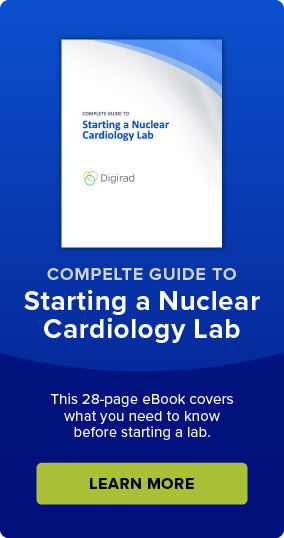One of the most important aspects of opening a nuclear cardiology imaging center is obtaining a radioactive materials license and accreditation.
As with any new venture, careful consideration of the regulatory landscape is paramount to a successful business plan. When opening a new facility, the focus is typically on the equipment, facility, and staff, but attention should be paid to your licensure and accreditation.
Licensure
Before your camera can scan the first patient, your practice has to be able to obtain radioactive materials. There are two primary paths to that end.
Outsourced Radioactive Materials License Provider
The first is a commercial agreement with a licensed and accredited service provider. There is a broad spectrum of these providers, and they vary significantly in quality, scope of service, cost, and geographic reach. This option will require you to use the organizations’ clinical staff, as they are the custodians of the radioactive material and corresponding regulatory requirements.
As with any buying decision, there is a cost/benefit continuum. The pros and cons of this option include:
Pros
- Shortened start-up time
- Less regulatory burden
- No need for in-house staff
Cons
- Cost
- Lack of control over staff
- Commitment to a lengthy contract
- Limited ability to choose your isotope provider
In-house RML Option
The second option is to obtain a Radioactive Materials License (RML) from your state or the NRC. Getting an RML is often one of the least understood components of starting a lab.
The requirements, timeline from application to receipt, and cost vary from state to state. Applications for RMLs can be as low as $2,000, while others may be as high as $10,000.
In addition to the financial considerations, many facilities and individuals fear going through this process. While it can be tedious and time-consuming, with some determination and patience, this process can generally be performed by a detail-oriented administrative staff member. A common approach is to hire a consulting physicist. Most state compliance bodies are willing to explain the requirements and answer questions.
Once the license has been issued, ongoing requirements will vary by state. A licensed Nuclear Medicine Tech (CNMT) can generally handle most required documentation. There will be some ongoing requirements to maintain your RML that vary by state. This may include annual physics reviews and or CEs for the staff. Again, a physicist consultant is often a part of the solution.
Accreditation
The second essential regulatory hurdle for a lab is accreditation, and it is a requirement for reimbursement by CMS and some private payers. CMS recognizes several accrediting bodies, so you’ll have some options to choose from.
Similar to the RML process, you can take two primary paths to obtain accreditation. You can either pay a service provider / consultant or do the administrative work to obtain on your own.
Each accrediting body has its own requirements, costs, and accreditation maintenance. If your practice already has a modality accredited, such as echocardiography, it would probably be easiest to stick with that accrediting body.
It would be worth exploring the different governing bodies if this is a brand-new practice or if no accreditations are currently in place.
To further explore your options or get a second opinion, feel free to contact our Nuclear Medicine Support Services team to learn more about how Digirad can assist your practice in obtaining licensing and accreditation.




